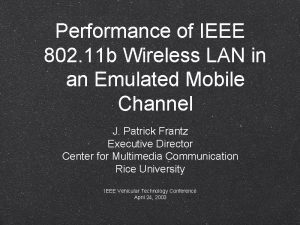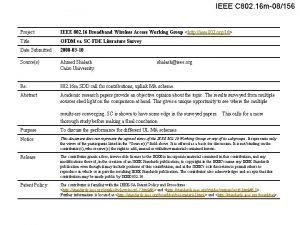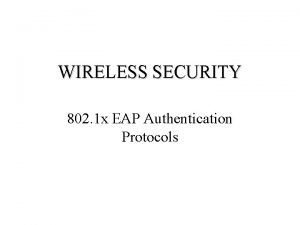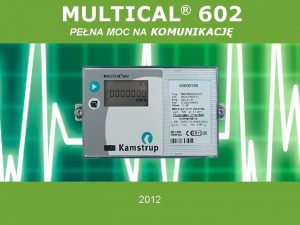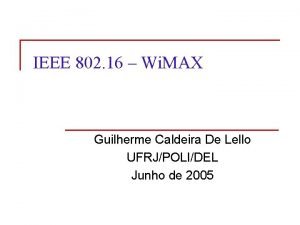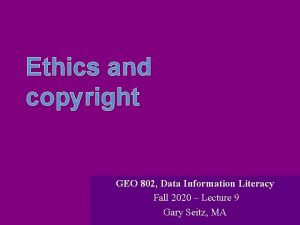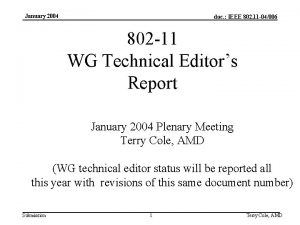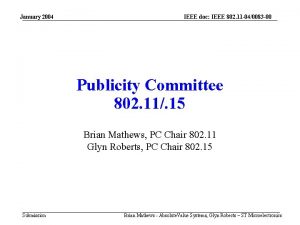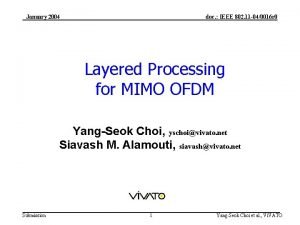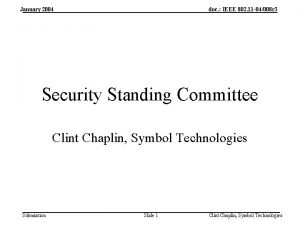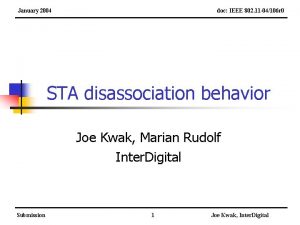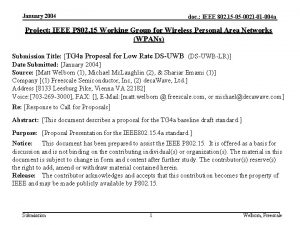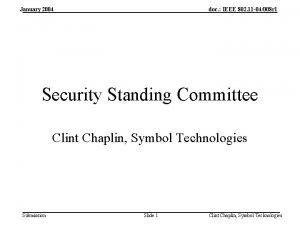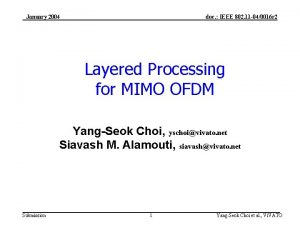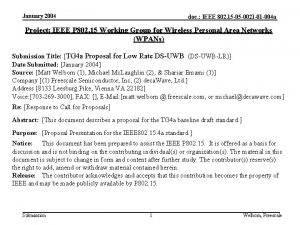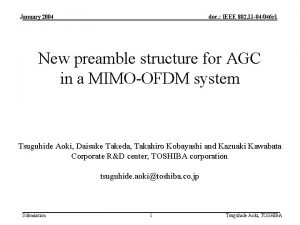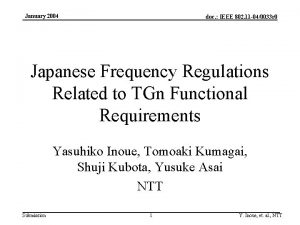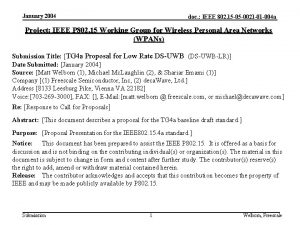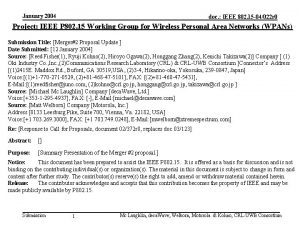January 2004 doc IEEE 802 11 040015 r

















- Slides: 17

January 2004 doc. : IEEE 802. 11 -04/0015 r 1 Comments on Ergodic and Outage Capacity Yang-Seok Choi, yschoi@vivato. net Siavash M. Alamouti, siavash@vivato. net Submission 1 Yang-Seok Choi et al. , Vi. VATO

January 2004 doc. : IEEE 802. 11 -04/0015 r 1 Questions? § From IEEE 802. 11 -03/940 r 1, TGn-channel-models Model (NLOS) Mean capacity in b/s/Hz % of iid mean capacity A (optional) 9. 1 83 B 8. 9 81 C 8. 6 78 D 10. 0 92 E 9. 3 85 F 10. 4 95 iid 10. 9 100 Table III: 4 x 4 MIMO channel mean capacity for the NLOS conditions at 10 d. B SNR. – Can we achieve 10 b/s/Hz at 10 d. B SNR? – If not, how much spectral efficiency can we get at 10 d. B SNR? – Model B provides better capacity than C? Submission 2 Yang-Seok Choi et al. , Vi. VATO

January 2004 doc. : IEEE 802. 11 -04/0015 r 1 Comments § The table may mislead 802. 11 n participants regarding practical interpretation of capacity. – The numbers are neither a lower nor an upper bound for 802. 11 n performance criteria (FER as a function of SNR for a given bandwidth efficiency) – Relative “theoretical” performance for the different channels (compared to iid) does not correspond to the relative practical difference for known techniques. § “Outage Capacity” is a more useful metric than Ergodic “Average Capacity”. § We suggest the table be updated and/or perhaps replaced. Submission 3 Yang-Seok Choi et al. , Vi. VATO

January 2004 doc. : IEEE 802. 11 -04/0015 r 1 Assumptions § Block Fading Channel – Channel is invariant over a frame – Channel is independent from frame to frame § CSI is available to Rx only – Perfect CSI at RX – No feedback channel § Gaussian codebook Submission 4 Yang-Seok Choi et al. , Vi. VATO

January 2004 doc. : IEEE 802. 11 -04/0015 r 1 System Models § where Submission 5 Yang-Seok Choi et al. , Vi. VATO

January 2004 doc. : IEEE 802. 11 -04/0015 r 1 “Instantaneous” Capacity § Capacity under given realization of channel matrix with perfect knowledge of channel at Rx § If transmitted frames have spectral efficiency less than above capacity, with arbitrarily large codeword, FER will be arbitrarily small § If transmitted frames have spectral efficiency greater than above capacity, with arbitrarily large codeword, FER will approach 100%. Submission 6 Yang-Seok Choi et al. , Vi. VATO

January 2004 doc. : IEEE 802. 11 -04/0015 r 1 Ergodic Capacity § Ergodic Capacity : Ensemble average of “instantaneous” capacity over all possible channel matrices § If , does this mean that in average we achieve 10 b/s/Hz spectral efficiency? – No in the sense of practical implementation! – But if CSI is available at Tx, by using adaptive modulation it can be true when the adaptive modulation can handle spectral efficiency from 0 to infinity. But if CSI is known to Tx, you can achieve better capacity. § Is it possible to achieve Ergodic Capacity? Submission 7 Yang-Seok Choi et al. , Vi. VATO

January 2004 doc. : IEEE 802. 11 -04/0015 r 1 Ergodic Capacity (cont’d) § How to achieve Ergodic capacity when CSI is not available to Tx? – At least, Your codeword should be spanned over all possible channel matrices. Otherwise there is no way to achieve Ergodic Capacity. – The codeword may have to be spread over all possible locations. – Or the frame duration should be much longer than coherence time. – And your coding structure should be able to achieve Ergodic capacity. § Ergodic capacity does not provide a useful metric Submission 8 Yang-Seok Choi et al. , Vi. VATO

January 2004 doc. : IEEE 802. 11 -04/0015 r 1 Outage Capacity § In fading channel, the capacity is a random variable. § Due to delay limitation, outage capacity is more meaningful than ergodic capacity § Outage capacity at outage probability § When – The above does not mean that in average we achieve 10 bps/Hz spectral efficiency – But it means that FER is 0. 5 even with ideal code if your frame has 10 b/s/Hz spectral efficiency Submission 9 Yang-Seok Choi et al. , Vi. VATO

January 2004 doc. : IEEE 802. 11 -04/0015 r 1 Outage Capacity (cont’d) § CDF in Log scale : Low outage probability is of interest (some consider zero-outage probability) – Recall definition of “Capacity” – Maximum rate without error – Linear scale may not reveal behaviors at low outage probabilities § Outage Probability – With ideal code, outage probability is equal to FER of which spectral efficiency is C 0 – With non-ideal code, outage probability is lower bound of FER – Slope of Log outage probability vs. Log SNR plot : Diversity Order – Slope of non-ideal code FER Diversity order Submission 10 Yang-Seok Choi et al. , Vi. VATO

January 2004 doc. : IEEE 802. 11 -04/0015 r 1 Outage Capacity (cont’d) § 100 Mbps MAC SAP – 150 Mbps PHY SAP : required spectral efficiency for OFDM systems = (PHY Overhead such as Preamble is excluded) § Capacity in 11 n – SNR=Received Signal Power per Rx antenna/Noise Power (at each subcarrier) where Submission is a channel matrix at subcarrier k assuming and Max delay<GI 11 Yang-Seok Choi et al. , Vi. VATO

January 2004 doc. : IEEE 802. 11 -04/0015 r 1 Outage Capacity (cont’d) § Outage Prob. 4 -by-4 MIMO OFDM(NLOS, No shadow fading) – 0. 5 l spacing Submission – 1 l spacing 12 Yang-Seok Choi et al. , Vi. VATO

January 2004 doc. : IEEE 802. 11 -04/0015 r 1 Outage Capacity (cont’d) § Loss due to – – Non-Ideal code (Space and Frequency diversity) Non-Ideal Channel Estimation Implementation Loss NF Submission 13 Yang-Seok Choi et al. , Vi. VATO

January 2004 doc. : IEEE 802. 11 -04/0015 r 1 Comparison Table (4 x 4) § Required SNR at 10% FER for 12. 5 b/s/Hz with ideal coding Submission Model (NLOS) 0. 5 l spacing 1 l spacing B 15. 6 d. B 13. 6 d. B C 15. 4 d. B 13. 4 d. B D 13. 2 d. B 12. 2 d. B E 14 d. B 13. 1 d. B iid (flat) 13. 4 d. B iid (200 nsec rms) 12. 1 d. B 14 Yang-Seok Choi et al. , Vi. VATO

January 2004 doc. : IEEE 802. 11 -04/0015 r 1 Comparison at PHY § Compare Proposals with ideal coding case – Slope – Required SNR at 10% FER Submission 15 Yang-Seok Choi et al. , Vi. VATO

January 2004 doc. : IEEE 802. 11 -04/0015 r 1 Thank you for your attention!! Questions? Submission 16 Yang-Seok Choi et al. , Vi. VATO

January 2004 doc. : IEEE 802. 11 -04/0015 r 1 Back-up § 100 Mbps MAC SAP – 150 Mbps PHY SAP : required spectral efficiency = (PHY Overhead such as Preamble is excluded) § Capacity in 11 n – SNR=Total Received Signal Power per Rx antenna/Noise Power (at each subcarrier) Capacity in OFDM where Submission is a channel matrix at subcarrier k assuming and Max delay<GI 17 Yang-Seok Choi et al. , Vi. VATO











